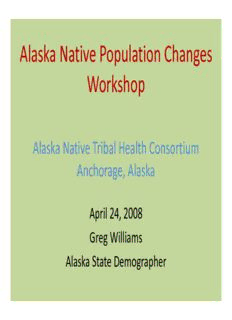
Alaska Native Population Changes Alaska Native Population Changes Workshop PDF
Preview Alaska Native Population Changes Alaska Native Population Changes Workshop
AAllaasskkaa NNaattiivvee PPooppuullaattiioonn CChhaannggeess Workshop Alaska Native Tribal Health Consortium Anchorage, Alaska Appril 24,, 2008 Greg Williams AAllaasskkaa SSttaattee DDeemmooggrraapphheerr Alaska State & Regional Population Trends for Allaskka Natiives && Totall Popullatiion • TThhiiss pprreesseennttaattiioonn wwiillll ccoovveerr tthhee ffoolllloowwiinngg:: • Total and Native Population Growth • Naturall Increase// Miigratiion • Out of State/In‐State Migration Trends • Change in age and the life cycle AAllaasskkaa NNaattiivvee PPooppuullaattiioonn • IInn 22000000 tthhee cceennssuuss iinnttrroodduucceedd mmuullttii‐rraaccee ccaatteeggoorriieess.. Alaska Native and American Indian “Alone” and “Alone and in Combination with some other race”. • Before 2000, they census forced a choice of one of four race groups: White, Black or African American, American Indian or Alaska Native, and Asian & Pacific Islander. AAllaasskkaa NNaattiivvee PPooppuullaattiioonn • TThhee pprroobblleemm hhaass bbeeeenn tthhaatt ootthheerr iinnddiiccaattoorr data such as Vital Statistics have not yet mmoovveedd ttoo ccoolllleecctt mmuullttii‐rraaccee ddaattaa. • Using fixed race numerators with “Alone” or “AAlloonnee oorr iinn CCoommbbiinnaattiioonn” ddeennoommiinnaattoorrss iinn rates will lower the incidence of the cchhaarraacctteerriissttiicc bbeeiinngg ssttuuddiieedd. BBrriiddggeedd EEssttiimmaatteess • FFoorr tthhiiss rreeaassoonn, uunnttiill ootthheerr mmuullttii‐rraaccee ddaattaa iiss available, we recommend Bridged Estimates. • Bridged estimates are an average of “Alone” andd ““AAllone or iin CCombbiinatiion”” andd are thhe most comparable to the 1990 race definition. AAllaasskkaa NNaattiivvee PPooppuullaattiioonn • IInn 22000066, wwee eessttiimmaatteedd AAllaasskkaa NNaattiivvee Population as follows: •• AAllaasskkaa NNaattiivvee oorr AAmmeerriiccaann IInnddiiaann “AAlloonnee”, 106,660 or 15.9%. • AAllaskka NNatiive or AAmeriican IInddiian ““AAllone or iin Combination”, 131,002 or 18.4%. • Bridged Series, 118,884 or 17.7%. PPooppuullaattiioonn CChhaannggee • WWhhaatt hhaavvee bbeeeenn tthhee ttrreennddss iinn PPooppuullaattiioonn change? •• HHaass tthheerree bbeeeenn ggrroowwtthh oorr ddeecclliinnee?? • Has it been rapid or slow? • What has accounted for the change? • What has been the role of uniqque historical events or predictable trends? NNaattuurraall IInnccrreeaassee oorr MMiiggrraattiioonn • DDeemmooggrraapphhiicc cchhaannggee iiss eeiitthheerr tthhee rreessuulltt ooff Natural Increase, Migration which are effected bbyy CCoohhoorrtt LLiiffee CCyyccllee cchhaannggee • Natural Increase = (Births – Deaths) • NNet MMiigratiion = ((IIn‐miigratiion – OOut miigratiion)) • life cycle change involves change in the number of persons of a given age experiencing a life cycle event (e.g., a first job) AAggee && LLiiffee CCyyccllee • SSoommee kkeeyy lliiffee ccyyccllee eevveennttss aarree:: • School attendance/ education • Househholldd Formatiion// CChhiilldd Bearing/Dissolution • Work/ Labor Force participation • Expperience of pplace ((e.gg.,, ggrowingg upp in rural Alaska) Overall Alaska Population Trends and Characteristics • TThhee ffoolllloowwiinngg sshhooww AAllaasskkaa’ss ggrroowwtthh ssiinnccee World War II and current distribution of AAllaasskkaa’ss ppooppuullaattiioonn.
Description: